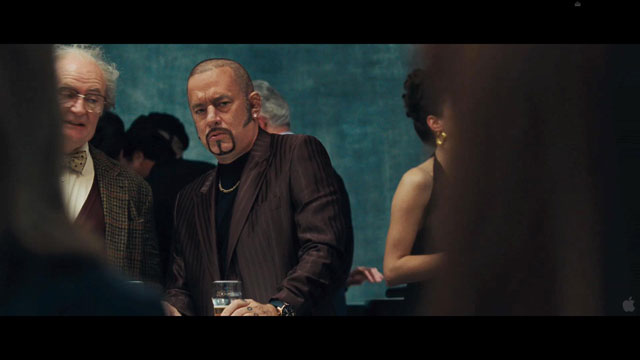Cloud Atlas is an enigmatic piece of cinematic marvelousness — the product of The Wachowskis’ ever increasing fascination with genre-blending tactics. Much has been said about this adaptation of David Mitchell’s novel including those who said that the book — which tells six, century-spanning tales, all interwoven in some way — was an unfilmable piece of literature.

Whether the film stayed true to the novel is beyond me — I haven’t read it. What I do know is never have I enjoyed myself for three hours straight inside of a cinema more than when I viewed this amazingly dense and wholly entertaining epic.
Starting in the 1800s, the film transfers us through six distinct stories: a 19th century sea-bound tale of sickness and slavery, a 1936 yarn in which a young and talented drifter befriends a brilliant composer, a 1970s detective-noir, a humorous and affable present day “prison-break” caper, a futuristic, action-packed “clone-war” story, and finally, a post-apocalyptic vision of bleakness and the struggle for survival.
All of these tales intersect one another during the film. In one scene you’re in Neo-Seoul (a futuristic city built above Seoul, Korea, which has succumbed to rising tides), the next you’re watching Halle Berry untie the knots of a nuclear company’s deadly conspiracy — no one story is told in a linear fashion. It’s this very device that may have some scratching their heads, but, if you pay attention, and keep a refreshed memory, the singular tales are not all that hard to follow.
The primary actors in the film, Jim Broadbent, Tom Hanks, Halle Berry, Hugo Weaving, Hugh Grant, Jim Sturgess and more, all appear in these yarns as different characters, not necessarily connected in any way to their counterparts. This may be another point of discomfort for casual viewers as this is not a film about reincarnation, though the idea is mentioned once or twice in the film.
To pinpoint and extract the exact meaning of this film is to delve into a surfeit of ideas, as there are many. Life and death. The everlasting fervor of love. The price of existence and the anguished nature of man. The ripple effect that our choices make not only on ourselves, but the occupants of the future who may brave the waters we have dipped. There are many ideas at work here, but I extrapolated one underpin — I expect critics and fans alike will have their own interpretations — that I deem the essence of what The Wachowskis and Tom Tykwer (Run Lola Run) were striving to express, and it can be summed up in one word: enslavement.
The term carries a negative connotation due to the enslavement of black people in the 19th century, something we’re given a view of during that specific installment of the film, but enslavement can take on other forms, not all necessarily negative.
Sure, there’s obvious bouts of enslavement portrayed in the film, such as the aforementioned, and, in the Neo-Seoul installment, clones are enslaved by a utilitarian government who keep the Asian women to do their bidding with the use of explosive devices strapped to their necks.
But, that’s just one form of slavery, a physical one. What’s more at work here is enslavement by way of information and beliefs. In the
This post-apocalyptic tale, in itself, is truly the Wachowskis playing with the idea of blind faith and necessity of religion,
In the 1936 segment, our lead character, a young brilliant man by the name of Frobisher, eventually finds himself trapped by his misdeeds and the ignorance toward his lifestyle choices. The same could be said for our anti-hero in the modern day segment: An old man finds himself the helpless victim of his brother’s scheme to have him committed to a brutally strict retirement facility.
And while we’re enslaved to the choices we make, and the choices others have made, we’re also enslaved to circumstance. In once scene, Tom Hanks’ character utters: “I wasn’t supposed to be here … did you ever think the universe was against you?”
Of course, I’m waxing philosophical upon this epic work, but to those who want a grand cinematic experience, this is as grand as it gets. Jaw-dropping set pieces, neon-injected thrill rides, adrenaline-laced action sequences, and everything else you could want from a film.
Also, I don’t believe too much attention should be paid to the narrative threads that sneak their way into each story, such as a journal that finds itself in several of the installments. These stories, unlike films like Crash and Amorres Perros, are much more connected by theorems and ideologies than they are narrative elements. To pay attention to those would be to miss the entire breadth of this piece of cinematic work.
With all that said, it’s not perfect. The Wachowskis and Tykwer come off a bit heavy-handed with a near constant stream of exposition and voice-over work that dumbs-down the film’s distillation, a tactic, most likely, used to help embrace the casual viewer, but I question even the validity of it as it may confuse more than include. I would have rathered the filmmakers allow us the chance to deduce the film’s primary extract without so much of their verbal input.
While many of the film’s characters try, in one way or another, to make their own deductions about life’s many intertwinings, it’s Halle Berry’s 1970’s journalist that comes the closest to the truth.
When examining the notes of Frobisher, she mentions that she’s just “trying to understand why we keep making the same mistakes.”
It’s because, in one way or another, we are all just prisoners of circumstance.
0 Comments